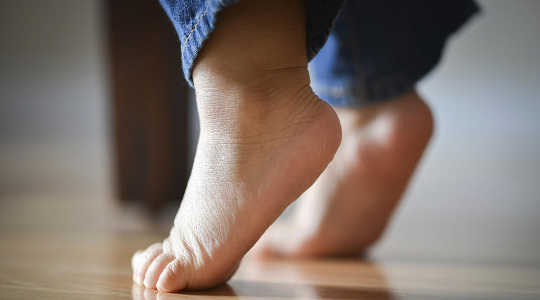
When toddlers are learning to walk, many spend some time walking up on their tip toes, which is known as toe walking. Commonly this is to get into things they aren’t meant to, but as they perfect their walking, they walk more with their whole foot on the ground.
The majority of toddlers will walk with their whole foot by the time they are three. Some toddlers are unable to walk with their whole foot, and this is something that should be checked out by a health professional.
Causes
Toe walking can be classified into four groups. Some neurological conditions such as cerebral palsy or muscular dystrophy cause the calf muscle to be tighter or change the way it works. This makes it hard or impossible for the child to get their heels onto the ground to walk with their whole foot.
There are also orthopaedic conditions such as congenital talipes equinovarus (also known as club foot) or calcaneal apophysitis (inflammation of the growth plate in the heel) which cause toe walking. The structural change in the foot or leg makes getting the heel to the ground impossible or painful.
However, some children who can get their heels to the ground prefer to walk up on their tip toes. This group of children also has other behavioural characteristics, such as delays in achieving milestones or ritualistic behaviours. Here toe walking is associated with autism spectrum disorders or developmental delay.
Then there are healthy children with no medical conditions who still persist in walking on their toes. This is known as idiopathic toe walking and is diagnosed through exclusion of all other medical conditions known to cause toe walking. Idiopathic toe walking has historically been called habitual toe walking with the presumption that the child has formed a habit of walking on their tip toes. It has also been called familial toe walking, as some studies report family members sharing the trait.
Idiopathic toe walking affects between 5% and 12% of healthy children and researchers don’t know its causes.
There may be a genetic cause as it is often seen in multiple family members. There are also other features often observed in children with this gait type. In some small studies, children with idiopathic toe walking have also shown speech and language delays and challenges with motor skills and sensory processing such as difficulty with balance and seeking out movement.
The most common observation in idiopathic toe walkers is tight calf muscles. This can make getting the heel to the ground even harder and can cause pain when children are trying to play sport. As you can imagine, children may be teased for walking differently.
What can be done?
No single treatment permanently fixes idiopathic toe walking. Often time is the greatest fixer as the children get heavier and the toe walking gets harder to maintain.
However, as many children with idiopathic toe walking also have tight calf muscles, many health professionals recommend treatment primarily focused on making these muscles longer. Tightness in calf muscles in adults has been known to cause trips, falls and foot and leg pain.
Treatment for idiopathic toe walking can be broken into two types: conservative and surgical.
Conservative treatment includes verbal reminders, stretching, heavy footwear, full-length orthotics, ankle foot orthotics, whole-body vibration, vinyl, carpet or gravel flooring, plaster casts to stretch the calf muscles, and injections of Botox into the calf muscles. Surgical intervention has primarily focused on lengthening the Achilles tendon.
Many of these treatments have limited evidence supporting their use.
At present, the best evidence supports plaster casts or surgery. Both of these treatments have shown the greatest improvement in the length of the calf muscles. Yet one longitudinal study found that many children who had been treated with serial casts or surgery still continued to toe-walk for up to 13 years after treatment.
Having multiple treatment options with varied success makes it hard for parents to choose the best treatment option. It’s also a challenge for doctors in knowing what treatment to recommend.
Researchers agree that keeping calf muscles long enough to easily make heel contact with the ground is important for children who are diagnosed with idiopathic toe walking. If this isn’t able to happen, a health professional will commonly then encourage treatment. There is also agreement that any child who is unable to get their heels to the ground at any time or continues to toe walk after three, should be assessed by a health professional.
About The Author
Cylie Williams, Adjunct Post Doctoral Research Fellow, Monash University
This article was originally published on The Conversation. Read the original article.
Related Books
at InnerSelf Market and Amazon

























